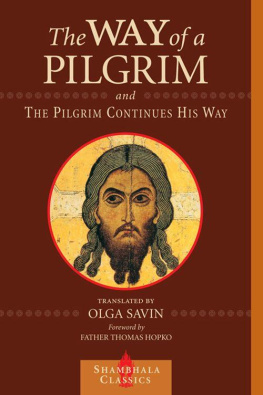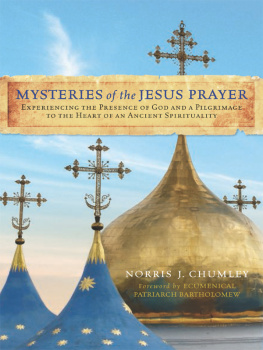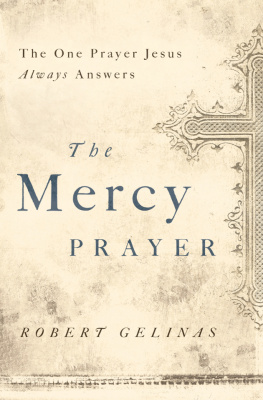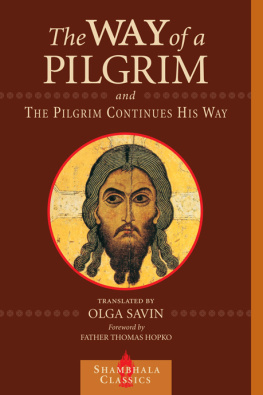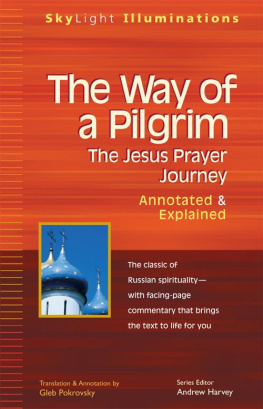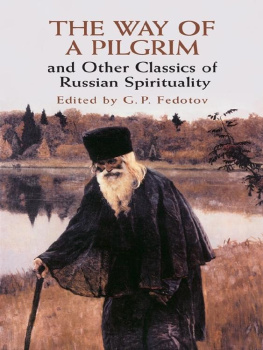The pilgrims journeys and his various encounters are recounted in an appealing, unaffected manner, and Savins flowing translation serves this tone well.
Publishers Weekly Religion BookLine
One of the most influential spiritual books of the last hundred years. It is one of those rare books that can make a difference in a persons life.
Jacob Needleman, author of Lost Christianity
ABOUT THE BOOK
This classic of world spiritual literature is the firsthand account of a pilgrims journey as he endeavors to live out Saint Pauls instruction to pray without ceasing. The narrator, an unnamed nineteenth-century peasant, sets out on his pilgrimage with nothing but a Bible, a rosary, and some dried bread. As he walks, he recites the Jesus prayer (Lord Jesus Christ, have mercy on me)a prayer that is said to quiet anxiety and fill the heart with love for all creation. With this prayer constantly on his lips, the pilgrim undergoes a profound spiritual education. This edition includes the sequel to The Way of a Pilgrim, entitled The Pilgrim Continues His Way, which contains a lengthy appendix reviewing the teachings of the Holy Fathers on the Jesus prayer.
OLGA SAVIN is a graduate of St. Vladimirs Orthodox Theological Seminary in Crestwood, New York.
Sign up to learn more about our books and receive special offers from Shambhala Publications.

Or visit us online to sign up at shambhala.com/eshambhala.
The Way of a Pilgrim
AND
The Pilgrim Continues His Way

TRANSLATED FROM THE RUSSIAN BY
Olga Savin
FOREWORD BY
Father Thomas Hopko

S HAMBHALA
Boston & London
2013
S HAMBHALA P UBLICATIONS , I NC .
H ORTICULTURAL H ALL
300 M ASSACHUSETTS A VENUE
B OSTON , M ASSACHUSETTS 02115
www.shambhala.com
Translation 1991, 2001 by Shambhala Publications, Inc.
Foreword 1996, 2001 by Thomas Hopko
All rights reserved. No part of this book may be reproduced in any form or by any means, electronic or mechanical, including photocopying, recording, or by any information storage and retrieval system, without permission in writing from the publisher.
LIBRARY OF CONGRESS CATALOGING-IN-PUBLICATION DATA
Otkrovennye rasskazy strannika dukhovnomu svoemu ottsu. English.
The way of a pilgrim ; and, The pilgrim continues his way / translated from the Russian by Olga Savin; foreword by Thomas Hopko.
p. cm.
eISBN: 978-0-8348-2564-2
ISBN: 978-1-57062-807-8 (pbk.)
1. Spiritual lifeOrthodox Eastern Church. 2. Jesus Prayer. I. Savin, Olga. II. Iz rasskazov strannika o blagodatnom deistvii molitvy Iisusovoi. English. III. Title. IV. Series.
BX382.O8513 2001
248.4819dc21 2001042048
CONTENTS

PUBLISHERS NOTE
Words marked with an asterisk in their first occurrence are found in the glossary.

T HE ORIGIN OF this little spiritual classic is in many ways a mystery. No one knows for certain if it is a literally true story written by the narrator, or an account cast in the first person about a particular pilgrim (or perhaps based on several), or even a marvelously creative piece of spiritual fiction intended to propagate a certain understanding of the practice of the Orthodox Christian faith, and the prayer of the heart, particularly the Jesus Prayer.
Whatever the origin and intention of the anonymous authors fascinating story, it makes several things clear to spiritual seekers. It affirms first of all that the source, goal and content of human life is not spirituality or religion, liturgical ritual or ascetical regimes, but the living God Himself. It tells us that life is communion with God: personal, direct, immediate, real, painful, peaceful, and joyful. It tells us that ceaseless prayer in pursuit of God and communion with Him is not simply lifes meaning or goal, the one thing worth living for, but it is life itself. It tells us that Jesus Christ is this life, and that constant, continual, ceaseless prayer in His name opens the door to Divine reality and puts us in immediate contact with the One who is the source, substance, and goal of our life, and our very life itself.
The pilgrim learns these things in the context of the Orthodox Church. His inspiration comes in the liturgical worship, which he faithfully follows and never abandons, and through the Bible, which he constantly carries with him as his greatest treasure. He searches for someone to help him to understand prayer and to practice it without ceasing. He finds people and writings that help him, often in the most unexpected places. He discovers the collection of writings of Christian spiritual masters, mostly Eastern and all Orthodox, called the Philokalia (which literally means love of the good and beautiful), with his whole life testifying to its teachings with disarming directness and awesome simplicity. What does he say about its message and teaching?
He says that one cannot practice ceaseless prayer in the name of Jesus outside the doctrinal and liturgical framework of the Christian Church and without the guidance and help of experienced teachers. He says that attempts to do this will be futile and fruitless and will inevitably lead to the spiritual delusion that is the perpetual risk of the spiritual seeker. While insisting on personal responsibility in the spiritual quest and on the radically personal character of prayer, the pilgrim insists equally on the need for participation in the community of faith with free and grateful obedience to its teachers and guides. He stresses the confession of sins and the need for perpetual repentance and moral conversion.
The pilgrim also stresses that the practice of prayer, which is the art of arts and science of sciences that proves everything else in a persons life, is a ceaseless labor whose fruit is always the result of Gods grace. It is a disinterested activitycharacterized by an interest only in Gods glory and the salvation of souls, first of all ones own. It provokes the demons to relentless and ruthless attack. It invites the ridicule and rejection of the world. It excites the passions of mind and flesh before it cures their misuse and heals their abuse, and directs them to their proper end. It is practiced not to gain extraordinary experiences or unique consolations. It teaches us to fear visions and voices and every such thing as the source of great temptation, confusion, and pain. It is always accompanied by the peace that passes understanding and the joy that no one can take away, yet it inevitably involves suffering, of which the pilgrim is the first witness. For the purpose of ceaseless prayer is not to remove the crosses of pain and difficulty, but to empower the praying person to endure them and even to embrace them with enthusiasm and joy as the sole source of happiness in this sad sinful world in which we find ourselves wandering as pilgrims in pursuit of our homeland.
The pilgrim also tells us that the constant repetition of the Jesus Prayer, or any other such prayer of the heart, is not a magical or mechanical means to spiritual peace and perfection. The prayer is not an incantation or a talisman. It is a personal calling upon the personal God. It is a petition for the Lord to act as He knows and wills for our purification, enlightenment, and deification in an unending life of growth and perfection.
Next page
